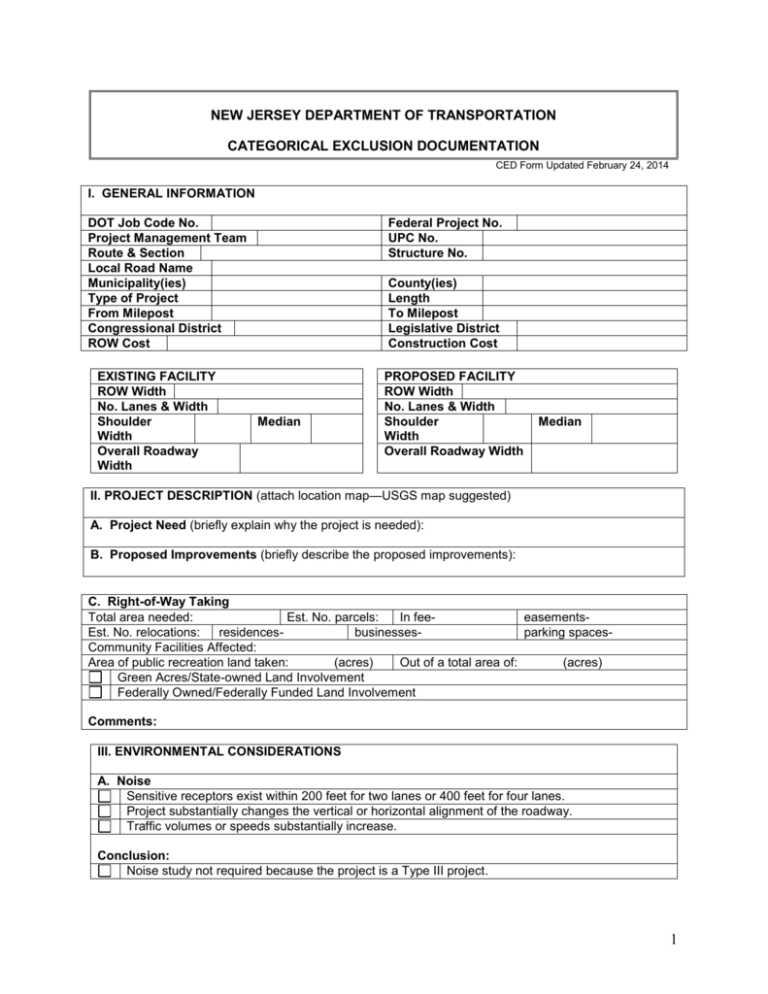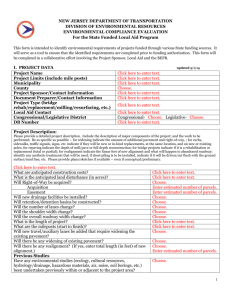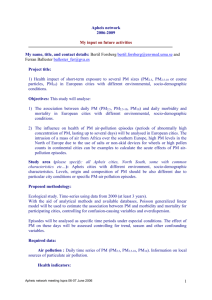Categorical Exclusion Documentation
advertisement

NEW JERSEY DEPARTMENT OF TRANSPORTATION CATEGORICAL EXCLUSION DOCUMENTATION CED Form Updated February 24, 2014 I. GENERAL INFORMATION DOT Job Code No. Project Management Team Route & Section Local Road Name Municipality(ies) Type of Project From Milepost Congressional District ROW Cost EXISTING FACILITY ROW Width No. Lanes & Width Shoulder Width Overall Roadway Width Federal Project No. UPC No. Structure No. County(ies) Length To Milepost Legislative District Construction Cost Median PROPOSED FACILITY ROW Width No. Lanes & Width Shoulder Width Overall Roadway Width Median II. PROJECT DESCRIPTION (attach location map—USGS map suggested) A. Project Need (briefly explain why the project is needed): B. Proposed Improvements (briefly describe the proposed improvements): C. Right-of-Way Taking Total area needed: Est. No. parcels: In feeeasementsEst. No. relocations: residencesbusinessesparking spacesCommunity Facilities Affected: Area of public recreation land taken: (acres) Out of a total area of: (acres) Green Acres/State-owned Land Involvement Federally Owned/Federally Funded Land Involvement Comments: III. ENVIRONMENTAL CONSIDERATIONS A. Noise Sensitive receptors exist within 200 feet for two lanes or 400 feet for four lanes. Project substantially changes the vertical or horizontal alignment of the roadway. Traffic volumes or speeds substantially increase. Conclusion: Noise study not required because the project is a Type III project. 1 Potential noise impacts were studied and are discussed in comments. Project still meets CE criteria. Comments: B. Air Quality: CONFORMITY WITH THE CLEAN AIR ACT AMENDMENTS (CAAA) OF 1990 Section 1: Regional Emissions Analysis (STIP or MPO’s conforming transportation plan) Project is included in the current approved State Transportation Improvement Plan (STIP). Project is not listed in the current approved STIP but is included in the MPO’s conforming transportation plan. Project is not included in either the approved STIP or the MPO’s conforming transportation plan. Section 2: Based on its scope, the project is categorized by the Transportation Conformity Rule (TCR) as: A project type listed in Table 2 of the TCR, i.e., Exempt from the conformity requirements of the CAAA (i.e., exempt from regional emissions analysis, Carbon Monoxide (CO) analysis, and Particulate Matter PM2.5 and PM10 analyses requirements) and may proceed towards implementation even in the absence of a conforming transportation plan and TIP. A project listed in Table 3 of the TCR, i.e., Exempt from regional emissions analysis requirement, but local effects of this project with respect to CO, PM2.5 and PM10 concentrations must be considered to determine if a hot-spot analysis is required. Complete Section 2a below. A project type not listed in Table 2 or Table 3 of the TCR, i.e., must be part of a conforming STIP and/or a MPO’s conforming transportation plan and requires CO, PM2.5 and PM10 hot-spot analyses. Complete Section 2a below. Section 2a(1): Project type listed in Table 3 of the TCR for CO analysis Project type not listed in either Table 2 or Table 3 of the TCR for CO analysis Project located in CO Attainment Area. CO analysis not required. Project may proceed to the project development process. The total eight-hour Carbon Monoxide levels are expected to be reasonably below the NAAQS of 9 ppm. This is based on LOS data for the intersection(s) and the total highest traffic volumes at this (those) intersection(s) and the distance of the sensitive receptors to the roadway. No quantitative analysis is required. Project may proceed to the project development process even in the absence of a conforming transportation plan and TIP. Project located in a Carbon Monoxide Non-Attainment/Maintenance Area and requires a Carbon Monoxide hot-spot analysis. A CO Analysis was completed at the following intersection(s): And the results are: Section 2a(2): Project type listed in Table 3 of the TCR for PM2.5 analysis Project type not listed in Table 2 or Table 3 of the TCR for PM2.5 analysis The project is located in PM2.5 Attainment Area. PM2.5 hot-spot analysis is not required. Project may proceed to the project development process. The project is located in a PM2.5 Non-Attainment/Maintenance Area and the project is not an air quality concern under 40CFR 93.123(b) (1). Quantitative/qualitative analysis is not required. Project may proceed to the project development process. The project is located in a PM2.5 Non-Attainment/Maintenance Area and the project is an air quality concern under 40CFR 93.123(b) (1). A PM2.5 hot-spot analysis was completed at the following location(s): And the results are: 2 Section 2a(3): Project type listed in Table 3 of the TCR for PM10 analysis Project type not listed in Table 2 or Table 3 of the TCR for PM10 analysis The project is located in PM10 Attainment Area. PM10 hot-spot analysis is not required. Project may proceed to the project development process. The project is located in a PM10 Non-Attainment/Maintenance Area and the project is not an air quality concern under 40CFR 93.123(b) (1). Quantitative/qualitative analysis is not required. Project may proceed to the project development process. The project is located in a PM10 Non-Attainment/Maintenance Area and the project is an air quality concern under 40CFR 93.123(b) (1). A PM10 hot-spot analysis was completed at the following location(s): And the results are: Comments (include LOS, if appropriate): C. Potential Ecological Constraints (check those that apply) Floodplains Shellfish Habitat Wetlands Acid Producing Soils Vernal Pools Submerged Aquatic Vegetation Waterbody: Sole Source Aquifer Category One Forested Areas Trout Production Threatened and Endangered Species: Trout Maintenance State-listed species Non-Trout Federally listed species Wild and Scenic River Other (specify): Essential Fish Habitat Federally Listed Threatened & Endangered Species Checklist: [See http://www.fws.gov/northeast/njfieldoffice/Endangered/consultation.html for guidance on the current US Fish and Wildlife Service (USFWS) Consultation Procedures.] No Effect: USFWS’s Information, Planning and Conservation System (IPAC) revealed no federally listed species potentially present in the project’s action area (see USFWS website). Therefore, the proposed activities will have no effect on federally listed species. Relevant general recommendations to protect other wildlife resources will be addressed in the project design. No further action is required under the Endangered Species Act. Potential Effect: USFWS’s IPAC revealed no federally listed species potentially present in the project’s action area. However, USFWS general recommendations to protect other wildlife species could not be implemented. Consultation with the USFWS required. USFWS’s IPAC revealed one (1) or more federally listed species as potentially present in the project’s action area. Section 7 Consultation required. USFWS Consultation: The project requires authorization under the Freshwater Wetlands Protection Act. USFWS consultation will be coordinated with the NJ Division of Land Use Regulation during permit time. NOTE: Depending on the potential level of impact, consultation may be initiated prior to permit application. (Explain in comments below.) The project is not anticipated to require authorization under the Freshwater Wetlands Protection Act. Consultation has been initiated with the USFWS NJ Field office. Correspondence attached. 3 Conclusion: No significant impact anticipated Further studies are needed to obtain permits. Project still satisfies CE criteria. Comments (briefly describe all potential ecological constraints): D. Anticipated Environmental Permits/Approvals/Coordination (check those that apply) US Coast Guard NJDEP Pollutant Discharge USACOE Section 10 (Navigable Waters) NJDEP Dam Safety USACOE Section 404 (Nationwide) NJDEP Remediation Approval USACOE Section 404 (Individual) NJDEP Tidelands Conveyance USEPA Sole Source Aquifer EO 11990 Wetlands NJDEP Freshwater Wetlands—GP EO 11988 Floodplains NJDEP Freshwater Wetlands—IP NJDEP Highlands Preservation Area: NJDEP Transition Area Waiver Exempt NJDEP Coastal Wetlands Highlands Applicability Determination NJDEP Waterfront Development Highlands Preservation Area Approval NJDEP CAFRA USDA-Farmland Conversion (Form AD 1006) NJDEP Flood Hazard Area Permit—GP NJ Agriculture Development Area NJDEP Flood Hazard Area Permit—IP NJDEP Green Acres Program/State House Comm. NJDEP Stormwater Management: National Marine Fisheries Service > 0.25 acre additional net impervious NJDEP Parks & Forestry (PL 2001 Chapter 10 surface Reforestation) > 1.0 acre disturbance D&R Canal Commission Unknown at this time Meadowlands Commission Approval through NJDEP LURP Pinelands Commission Permit (or) NJDOT self-certification Endangered Species Act Section 7 Consultation NJPDES Construction Activity Stormwater NJDEP Threatened & Endangered Species GP (RFA) Coordination NJDEP Water Quality Certificate Other (specify): Comments: E. Cultural Resources Technical Findings: Project is not an undertaking for Section 106 purposes; concurrence has been received from FHWA. No Effect per DOT/SHPO Agreement of 05/14/09; subject to conditions identified in the Agreement. No Section 106 Consultation per 5/25/01 SHPO concurrence with Section 106 Compliance Procedures, Federally Funded Drainage Improvement Program; subject to conditions identified in the Agreement. No Effect to significant properties if they exist in Area of Potential Effects (APE) per 36CFR800.3(a)(1) with SHPO concurrence. (Because the Section 106 regulations allow for a level of effort for conducting and evaluating cultural resources to be commensurate with the undertaking, this category of finding was developed to be used for certain projects when no cultural resources survey has been conducted; and self-imposed conditions, if applicable, are presented as part of the undertaking, e.g., Pipeline 3 or other small-scale projects.) No National Register (NR) listed or eligible properties in APE (Section 106 Findings = No Historic Properties Affected). 4 New Jersey Register listed properties in APE (see comments and K. Environmental Commitments below). National Register listed/eligible properties exist within APE (see consultation summary below). Archaeology Bridge Architecture Building District Other Section 106 Finding NR listed/eligible property(ies)— No Historic Properties Affected NR listed/eligible property(ies)— No Adverse Effect (NAE) NR listed/eligible property(ies)— NAE with conditions NR listed/eligible property(ies)— Adverse Effect Section 106 Consultation Summary FHWA concurred with Adverse Effect Finding SHPO provided Section 106 consultation comments FHWA concurred with No Adverse Effect with Conditions ACHP notified of Adverse Effect ACHP responded to notification (check one/enter date): ACHP will participate in consultation ACHP declined to participate in consultation MOA executed by FHWA (check one/enter date): MOA filed with ACHP ACHP accepted/signed MOA Date Comments (include MOA stipulations or other conditions, if applicable) : F. Section 4(f) Involvement Section 1: Historic Sites No Section 4(f) Involvement Project results in a “constructive use” of Section 4(f) property. Project results in a use of Historic site(s) on or eligible for the National Register of Historic Places (check one below): Section 4(f) Involvement. Project is covered under de minimis Evaluation of Impacts and all applicability criteria have been met, including concurrence first by the FHWA that the project meets the applicability criteria, and then concurrence by SHPO with the “No Effect” or “No Adverse Effect” determination after they are notified of the intent to use a de minimis finding. Section 4(f) Involvement. Project is covered under the Nationwide Section 4(f) Programmatic Evaluation for minor involvement and all applicability criteria have been met, including concurrence by the SHPO (or ACHP) with the “No Effect” or “No Adverse Effect” determination. Section 4(f) Involvement. Project is covered under the Nationwide Section 4(f) Programmatic Evaluation for Net Benefits and all applicability criteria have been met, including notification to and concurrence by the FHWA with the determination. Section 4(f) Involvement. Project has an “Adverse Effect” determination. Individual Section 4(f) was prepared. Comments: 5 Section 2: Historic Bridges No Section 4(f) Involvement Section 4(f) Involvement. Project is covered under the Nationwide Section 4(f) Programmatic Evaluation for Historic Bridges. Comments: Section 3: Publicly Owned Park, Recreation Area, Wildlife or Waterfowl Refuge No Section 4(f) Involvement Project results in a “Constructive Use” of Section 4(f) property (fill out Site Information below) Project requires acquisition from publicly owned recreation land (fill out Site Information below): Section 4(f) Involvement. Project is covered under de minimis Evaluation of Impacts and all applicability criteria and conditions have been met, including concurrence first by the FHWA that the project meets the applicability criteria, and then notification to the officials with jurisdiction of the intent to use a de minimis finding. Section 4(f) Involvement. Project is covered under Nationwide Section 4(f) Programmatic Evaluation for minor involvement and all applicability criteria and conditions have been met, including concurrence by the officials having jurisdiction over the property. Section 4(f) Involvement. Project is covered under the Nationwide Section 4(f) Programmatic Evaluation for Net Benefits and all applicability criteria have been met, including notification to and concurrence by the FHWA with the determination. Section 4(f) Involvement. Nationwide Section 4(f) Programmatic applicability criteria were not met; Individual Section 4(f) Evaluation was prepared. Site Information (for projects involving “Constructive Use” or acquisition from publicly owned recreation land, wildlife or waterfowl refuge): Name of Site (use local name): Lot and Block: Total acreage of site: Acreage of site affected (acquisition and permanent easements): Federal encumbrances involved (e.g., Wild and Scenic Rivers Act, Land and Water Conservation Fund Act, Rivers and Harbors Act). Comments: Section 4: Independent Walkway & Bikeway Construction Projects No Section 4(f) Involvement Section 4(f) Involvement. Project is covered under the Nationwide Section 4(f) Programmatic Evaluation. Project requires use of recreation and park areas established and maintained primarily for active recreation, open space, or similar purposes. All applicability criteria have been met, including approval in writing by the official with jurisdiction over the property that the project is acceptable and consistent with the designated use of the property and that all possible planning to minimize harm has been accomplished in the location and design of the bikeway or walkway facility. Comments: G. Hazardous Materials and Landfills Known or suspected contaminated site within project limits. 6 Underground storage tanks within project limits. Questionable fill material within project limits. Conclusion: Low potential for involvement with contamination; no further investigation required. Low potential for involvement with contamination; verification required based upon plan review. Further investigation and/or sampling required to determine extent of involvement with contamination. Project still meets FHWA criteria for a CE. Comments: H. Socioeconomics The project will not result in any significant socioeconomic impacts. Comments: I. Environmental Justice Project will have no disproportionately high or adverse effects on low income and/or minority communities. Project will have disproportionately high and adverse effects on low income and/or minority communities. Conclusion: Project is in compliance with the goals of Executive Order 12898 and the requirements of the Civil Rights Act of 1964. Project is in compliance with the goals of Executive Order 12898 and the requirements of the Civil Rights Act of 1964, through the identification of measures to address disproportionate effects, including actions to avoid or mitigate them. Project satisfies CE criteria. Comments: J. Public Reaction (briefly describe input from the Office of Community Relations or current status of public reaction): K. Environmental Commitments (refer to MOA stipulations or other conditions noted in Section D, if applicable; permit conditions, etc.): 7 DETERMINATION OF CATEGORICAL EXCLUSION Project name and location: CE #: The proposed project satisfies the Categorical Exclusion definition outlined in 23 CFR 771.117 (a) and will not result in significant environmental impacts. Prepared/Reviewed by: Environmental Coordinator Date Environmental Supervisor Date Project Manager, Division of Project Management Date Manager, Bur of Landscape Arch Environ Solutions Date Division Administrator, Federal Highway Administration Date Recommended by: Certified (or) Approved Concurrence (non-self certified CEs) enclosures (please include any correspondence referenced in the CED): Project Location Map NJ Natural Heritage Program letter USFWS coordination letter(s) (e.g., IPAC Species List, Effects/No Effects Determination, etc.) NMFS coordination letter SHPO Eligibility & Effects concurrence letter Signed MOA Final Nationwide Section 4(f) Programmatic Evaluation for: Minor Involvement with Historic Sites Use of Historic Bridges 8 Minor Involvement with Publicly Owned Park, Recreation Area, Wildlife or Waterfowl Refuge Independent Walkway and Bikeway Construction Projects Net Benefits De minimis Evaluation of Impacts documentation (i.e., notice to SHPO, de minimis template) Final Individual Section 4(f) Resolution of Support from Municipality/County Other (specify): 9



